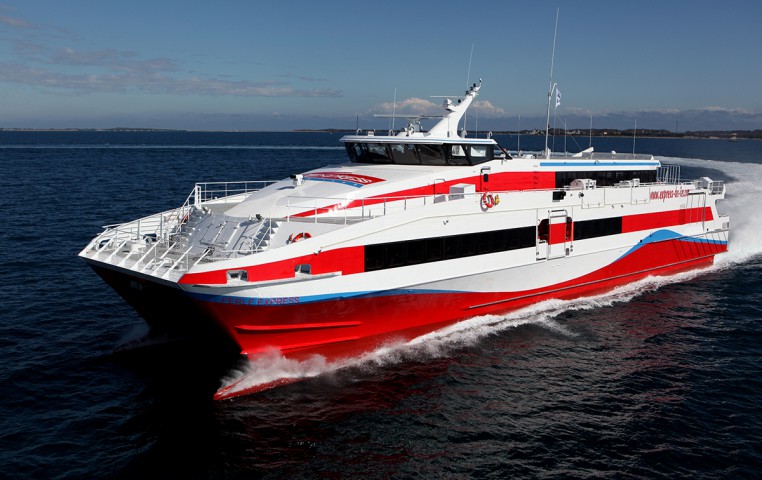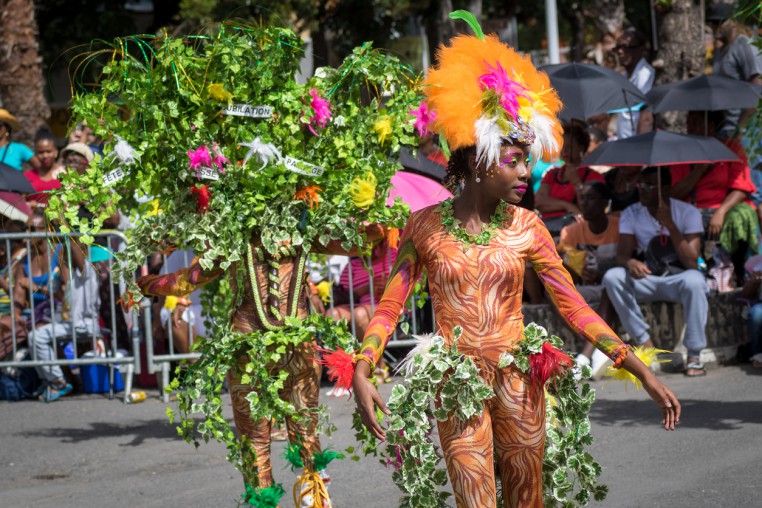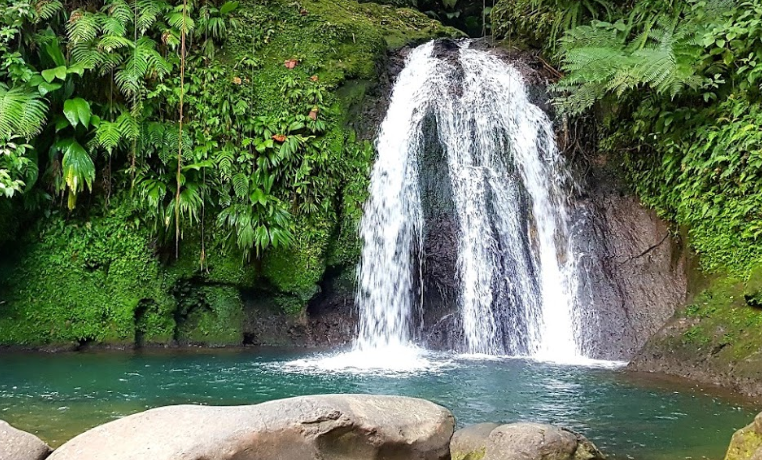The butterfly of the Caribbean, Guadeloupe is a French territory made up of as many as 12 islands (many people have a misconception that Guadeloupe is a name of an island). It is “the butterfly” because its two biggest islands, Grande Terre and Basse Terre form together to the shape of this insect when looking down on to them from a satellite view. It is these two islands that make up most of the territory and it is here that 90% of its population live. However, every island of this archipelago has something different and special to offer and, henceforth, if you decide to come this way, be prepared for many island hoping trips and a big diversity of experiences and sights!
| KEY FACTS | |
|---|---|
| Size | 629 square miles (1,628 square kilometers) |
| Population | 430,000 (80% black, 5% white, 15% other) |
| Status | French overseas territory |
| Official language(s) | French, Creole |
| GDP per capita (2012) | $25,479 |
| Currency | Euro |
| Electricity | European standard with two prongs |
| Driving | on the right |
Guadeloupe has a very rich history of colonial conflicts and internal struggles. Though it was named by Columbus (full name being “Santa María de Guadalupe de Extremadura”), who landed here first in 1493, it was the French who properly colonized these islands in the 17th century. The colonization also meant bringing in an extensive slave labour force from Africa to work on local sugar plantations, which became very profitable very quickly due to farming friendly climate. The wealth that Guadeloupe stared generating attracted the attention of the British Empire, which took control of the territory several times between 17th and 19th centuries. The French managed to regain full control of Guadeloupe in 1815, but the colonial conflicts were not the end of dramatic historical events here. A large eruption of the La Soufrière volcano on Basse-Terre in 1843 killed thousands of locals followed by more violent eruptions in 1902, 1971 and 1979 last time around. Slavery was abolished in 1848, but less than ten years later the islands suffered a cholera epidemic that killed thousands. In the second part of the 20th century Guadeloupe got its own representation in the French parliament and for the last several decades it has enjoyed a period economic and political stability.

Today, the islands prosper extensively from tourism, which is dominated by visitors from, where else, France. The fact that Guadeloupe is part of the European Union means that the local currency is Euros and all EU citizens can legally work and live here (If you live in northern Europe, maybe it’s time to leave the cold behind and settle in this paradise). The territory is famous for its friendly Creole (a mix of European and African) culture and cuisine. In fact, some of the best restaurants serving creole dishes are located here. However, what is probably most appealing about these islands is the fact that they still remain much undeveloped and are home to beautiful wild beaches as well as lush jungles and mountains that offer some of the most spectacular, though challenging, hiking in the Caribbean. Get your trail shoes ready!
Getting there
Guadeloupe has only one international airport located on Grande-Terre near the city of Ponte-a-Pitre and there are only two airports in North America offering direct flights to it all year round – Miami and Montreal. You can also find seasonal flights from New York JFK operated by Norwegian Airlines. As you may guess, the most direct flights to Guadeloupe operate from France. There are as many as five non-stop flights going out from Paris every day. Hence, if you live anywhere else in Europe you will most likely be connecting here. One other way of getting here to consider is to do it via a connecting flight through St.Marteen or Martinique. Local airlines (like Air Caraibes) offer daily flights between these islands so you can maximise your vacation by staying a couple days on each of the three islands and taking quick, 30 minute flights between them.
Getting around
Guadeloupe is a little tricky when it comes to getting around its islands, especially the smaller ones. Car supply is pretty limited, which means taxis as well as rentals are in high demand and get can very expensive in season and on the weekends. Generally, the exception to this is the biggest city of the islands, Pointe-a-Pitre, which gets busy with car traffic and operates a bus service that connects it to all of the smaller towns on Grande-Terre. Due to its mountainous terrain, Basse-Terre has many less roads than Grande-Terre, but you can still get around most of the island in a car and, if you rent on Grande-Terre, you can drive to Basse-Terre through several of the bridges that connect the two (mainly Pont de l’Alliance and Pont de la Gabarre).
There are hardly any cars available for tourists on Marie-Galante, La Desirade and Les Saintes, but you can still book ahead a taxi service at least at the first two destinations. To get to these islands, your best bet is a ferry and the routes available are:
- null
- Pointe-a-Pitre (Grande-Terre) to Saint Louis (Marie-Galante) – operates several times a day and take less than an hour
- Pointe-a-Pitre (Grande-Terre) to Terre-de-Haut (Les Saintes) – operates several times a day and take less than an hour
- Saint Francois (Grande-Terre) to Grande-Anse (La Desirade) – operates twice a day and takes about 40 minutes
- Trois Rivieres (Basse-Terre) to Terre-de-Haut (Les Saintes) – operates four times a day and takes 15 minutes
- Trois Rivieres (Basse-Terre) to Terre-de-Bas (Les Saintes) – operates several times a day and takes 20 minutes
Finally, if you are keen to visit several of the uninhabited islands of the archipelago like Iles de la Petite Terre or Gand Illet, you can do so by renting a boat or taking a group trip from Pointe-a-Pitre.

Things to explore
Each of the Guadeloupe islands offers something different. Grande-Terre is relatively flat with many rolling hills in the center and a varied coast of cliffs, marshes and many bays filled with sandy beaches. It is the most developed of all the islands with Pointe-a-Pitre being its biggest city (also being the biggest city of the archipelago. You will find many historic sites here including creole styled catholic church of St. Peter and St. Paul, the Victory Square filled by several beautiful statues of historic significance as well as locally popular church of Eglise de Massabielle. The city is also 0host to several key museums of Guadeloupean history and culture. The most impressive of them is Memorial ACTe, a modern building full of tales and exhibits of dramatic history of the islands and their people.
If you venture just a couple miles south of Pointe-a-Pitre you can visit a large fortress from the 18th century, Fort fleur d’épée, and if you keep going just another mile or to you will enter the town of Le Gosier, which is home to an impressive aquarium in its marina as well as a museum of (historical) costumes called Musee Camelia Costumes et Traditions. Le Gosier itself is also a lovely town for a walk along the beach. It has lots of quiet bays and there are many restaurants and bars nearby to relax and fill yourself up. However, Grande-Terre has lots of fantastic beaches and many of them are especially popular with surfers as its northern coast faces the more unsettled Atlantic coast. This includes plage De L’Autre Bord in Le Moule, which is also a great town to explore on foot if you have the opportunity. Now, if what you are really looking for is stunning nature in its wildest form the one place on Grande-Terre is its farthest eastern tip of Pointe des Chateaux. This spot has a combination of everything a nature seeker would want: lovely bush trails, open sandy beaches and spectacular rock formations hit by ocean waters with immense power and effect. The beach here is a great place for snorkelling and surfing and you are likely to be only one of few people on the beach.
Basse-Terre is the second biggest island of Guadeloupe and in many respects, the most interesting one. The national park located here, Parc national de la Guadeloupe, is a proper jungle measuring tens of miles across and is a protected bioreserve containing some of the rarest species or plants and animals on earth. There are lots of ways of exploring the park and getting to its crown jewel of La Soufriere volcano, but if you are driving a car, a good spot to start your explorations is from a car park of Parking de la Troisième chute du Carbet. From here you can take a trail that will take you through multiple tall waterfalls (Chutes du Carbet) and straight on to a fantastic views of the volcano and big parts of the island below. If long hiking is not your thing, you can still explore Basse-Terre’s amazing nature in other places like the Jardin Botanique park. Exploring it still requires much walking, but it the setting is much more like an actual park with many types of plants carefully planted and maintained. Kids, especially, will enjoy meetings of lots of parrots, flamingos and goats here. Two other cool spot to highlight on Basse-Terre is Zoo de Guadeloupe au Parc Des Mamelles and Grande-Anse beach. The first one showcases hundreds of Caribbean animals in a beautiful jungle setting, whereas the other is a picturesque mile long stretch of sand in the north of the island, much popular among the locals (and hence, to be avoided on Sundays).
When it comes to the other islands of the archipelago, you will find a couple amazing rum distilleries and rum shops on Marie-Galante, Fort Napoleon tower built in 1777 with expansive views of all of Les Saintes islands on Terre-de-Haute, as well as thousands or iguanas on trails of Réserve Naturelle Nationale on La Désirade. The smaller islands also have some good beaches, though don’t expect many amenities around. Our own personal favorite beach on the lesser Guadeloupe islands is in the town of Capesterre-de-Marie-Galante. The turquoise calm waters are in contrast here to red roofs of houses. The beach and the town have a very relaxed feel and it seems like everyone around is a close friend. If you come here, you may decide to linger for months!
[embedyt]https://www.youtube.com/watch?v=KPtWWLWB1Uw[/embedyt]Accommodations
Accommodations are available on six of the archipelago islands and not surprisingly, 80% of hotels and apartments for rent are located on the two biggest islands, Grande-Terre and Basse-Terre. Prices and types of accommodations can very greatly and so its possible to stay on the islands on a very low budget of less than $100 per night as well as splash out as much as $1,000 per night. If you are looking for resort type hotel, look no further than Le Gosier and Ste-Anne as it is here where you will find most of the bigger resorts with pools and spas. Just two to consider, which both have high ratings, are La Creole Beach Hotel & Spa and Club Med La Caravelle.
Otherwise, consider the fact that Guadeloupe is awash with villa type boutique hotels and apartments owner and run by local families. You can find them pretty much everywhere on the main islands and even as close as 6 kilometres away from the top of La Soufriere volcano (in the town of Saint-Claude). Majority of the villas are located inland on hills overlooking green and blue areas below and offering secluded rooms with great views and much privacy. There are a couple ways you can find such villas: visit a website of the popular local rental agency like Prestige Villa Rental, try a search on a hotel comparison website or open Google maps, zoom in on a location you are interested in and type in hotels in the search box.
Food & restaurants
Guadeloupe is by many considered the home of creole cooking. Hence, many menus here are full of dishes that mix African, Indian and European flavours into unique combinations not found anywhere else in the world! Creole dishes take time to make and they are rich in vegetables, fish and meat. Also, although they are rich in flavour, they are not necessarily spicy (though can be very much so!). The restaurants serving creole food are located throughout all the populated islands though the most popular and highest rated ones are on Grande-Terre and Basse-Terre. Of course, if rather than trying new dishes you rather stick to the more standard European or Caribbean food, you won’t be disappointed either. There are plenty of French, Italian, Indian and Caribbean restaurants here as well with the classic menus full of pastas, pizzas, fish dishes and stews.
Nightlife
The nightlife vibe in Guadeloupe is laid back and all about local music, tasty mixed drinks and vivid conversations. All this happens in small and locally owned bars, of which will find about ten around Pointe-a-Pitre (La Boca is our favorite here!), four to five around Basse-Terre and two on Terre-de-Haut. When visiting most of the bars, expect to find a cocktail menu full of rum based drinks, lots of outdoor spaces and tables as well as many local bands playing beguine and folklore music until late night hours. Alternatively, you can also check out a couple bars and casinos that are part of the bigger hotels. There are a couple of them around Le Gosier and Ste-Anne and they offer dance and circus shows, weekend dancing and gambling (most popular are Eden Palm Theater and La Rhumerie Bar & Lounge).

Sports & adventure
Water sports and mountain hiking are the two biggest draws of Guadeloupe. Divers will not want to miss visiting Réserve Cousteau, an extensive underwater coral park on the eastern side of Basse-Terre. It can get busy here, but the sights underwater are definitely worth the trip. You can also come with an organized group here all the way from Pointe-a-Pitre; they will provide you with all the necessary gear and you will be accompanied by a professional instructor/tour guide. Two other fantastic diving locations in Guadeloupe are the waters of Port Louis on Grande-Terre, home to a large coral reef and a sunken Cesna 188 plane that can be explored at 80 feet as well as the main bays of Les Saintes where it is less busy and you may even dive into a bunch of friendly dolphins! Les Saintes islands are also a popular sailing and fishing spot as you can easily set anchor in one of its coves and have the waters around you pretty much to yourself. In fact, several of the bigger marinas of Guadeloupe offer boat charters with or without a skipper depending on your sailing skills. Once you got a boat and are keen for some big game fishing, head to the western coast of Basse Terre, which is one of the best spots in the Caribbean for catching the bigger species all year round.
When it comes to hiking, one cannot ignore the Parc National de la Guadeloupe, which is a jewel of natural beauty and diversity not only of Guadeloupe, but all of the Caribbean. Many 60 feet tall waterfalls are scattered throughout the park and if you arrive to them early enough, you will be able to enjoy their beauty on your own. Of course, the main attraction of the park is the La Soufriere volcano, and you can walk on a trail that takes you right on the edge of the center of it, tens of feet away from cracks spewing hot volcano air. What many people don’t know is that just a mile away from the top of La Sourfiere is another, inactive volcano called Lac Flammarion. Here as well, you can also get very close to the center, which is filled with a shallow lake and surrounded by bushes. Elsewhere on Guadeloupe a fun spot to hike are the trails of Pointe des Chateaux, which take you along and into a couple lovely beaches as well as to a impressive views of water-shaped cliffs. Finally, Gueule Grand Gouffre on Marie-Galante is less of a hike, but this water shaped hole and arch are a unique and picturesque landmark that is easily accessible through a dirt road on the north coast of the island.

Safety and security
As an integral part of France, Guadeloupe can be considered one of the most developed territories in the Caribbean. With a advanced economy and much support from the motherland, Guadeloupe is a stable and safe place to visit. Of course, you should remain vigilant and keep your passport and money safe whenever out in the towns or on trails. In addition, as many parts of Guadeloupe are very remote, it is ill-advised to venture alone into unknown parts of the islands as you may run into trouble, more so from nature, weather and terrain instead of the locals. Hiking on Basse Terre can be especially treacherous and its not difficult to get lost in its national forest. Get a guide, a compass and water resistant hiking shoes when preparing for a trip here.
The best beaches in Guadeloupe
Six populated islands comprise the archipelago of Guadeloupe. Alongside the uninhabited islets, the two main…

